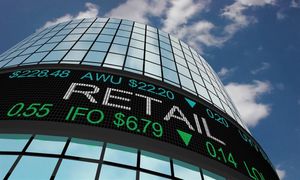
The United States economy finds itself at a critical juncture in August 2025, grappling with a stubborn inflation problem that continues to defy the Federal Reserve's targets, even as clear signs of an economic slowdown and a weakening labor market emerge. This confluence of factors presents a challenging landscape for investors, businesses, and consumers alike, raising concerns about a potential period of stagflation where economic growth stagnates while prices continue to rise.
The persistent inflationary pressures, exacerbated by recent tariff implementations, are forcing companies to pass on higher costs, impacting consumer purchasing power. Simultaneously, a noticeable deceleration in job creation and a rising unemployment rate signal a cooling, if not outright weakening, labor market. This delicate balance has policymakers and market participants closely watching for the Federal Reserve's next moves, with growing expectations of interest rate adjustments to navigate these turbulent economic waters.
The Unfolding Economic Narrative: Persistent Inflation Meets a Softening Economy
The narrative of the U.S. economy in mid-2025 is one of complex and often contradictory signals. While the second quarter of 2025 saw a rebound in Gross Domestic Product (GDP) growth, a deeper dive into the data reveals underlying fragilities that suggest a more pronounced slowdown is on the horizon. Real GDP increased at an annualized rate of 3.0% in Q2 2025, a seemingly robust figure following a 0.5% contraction in Q1. However, this growth was largely driven by a significant decrease in imports and an increase in consumer spending, rather than a fundamental strengthening of private sector demand. Conversely, private sector investment plunged by 15.6% in Q2, and exports fell by 1.8%. Final sales to private domestic purchasers, a key measure of underlying domestic demand, increased by only 1.2% in Q2, indicating a less vibrant economic core than the headline GDP figure suggests. Analysts at EY, for instance, project real GDP growth to slow to 0.9% year-over-year by Q4 2025, labeling the strong Q2 GDP figure as an "economic mirage."
Inflation remains a significant concern, consistently exceeding the Federal Reserve's 2% long-term target. As of July 2025, the Consumer Price Index (CPI) increased by 2.7% year-over-year, with the core CPI, excluding volatile food and energy prices, accelerating to 3.1%. The Personal Consumption Expenditures (PCE) price index, the Fed's preferred gauge, increased by 2.1% in Q2 2025, with core PCE rising by 2.5%. Despite some moderation from earlier peaks, all major inflation measures remain elevated. Expert consensus points to recently enacted tariffs as a contributing factor to these persistent price pressures, with companies increasingly passing on higher costs to consumers. Bank of America (NYSE: BAC), for example, anticipates core PCE inflation to continue trending higher, suggesting that the battle against inflation is far from over.
The labor market, once a beacon of strength, is now showing clear signs of weakening. The unemployment rate climbed to 4.2% in July 2025, up from 4.1% in June. Nonfarm payroll employment saw a modest increase of only 73,000 in July, significantly missing the consensus estimate of 115,000. Furthermore, job gains for May and June were revised downward by a substantial 258,000 jobs, indicating a more pronounced slowdown than initially reported. The average monthly job creation over the past three months has plummeted to 35,000, a stark contrast to the 168,000 average seen in 2024. Job losses are accumulating across various industries, including manufacturing, government, and professional and business services. While real average weekly earnings saw a modest increase, wage growth for the lowest-paid quarter of workers has slowed, and the labor force participation rate remains subdued at 62.2%. Federal Reserve Chair Jerome Powell has acknowledged these rising job market risks, even amidst persistent inflation, hinting at a possible September interest rate cut, a significant shift in the Fed's stance.
Navigating the Crosscurrents: Potential Winners and Losers in a Shifting Economy
In an economic environment characterized by persistent inflation and a weakening labor market, certain sectors and companies are poised to fare better or worse than others. Companies with strong pricing power and those operating in essential goods and services may emerge as relative winners, while discretionary spending-dependent businesses and those heavily reliant on robust consumer demand could face significant headwinds.
Companies that can effectively pass on increased input costs to consumers without a substantial drop in demand are likely to maintain profitability. This often includes firms in the consumer staples sector, such as major food and beverage producers like PepsiCo (NASDAQ: PEP) or Procter & Gamble (NYSE: PG), whose products are considered necessities. Similarly, healthcare providers and pharmaceutical companies, like Johnson & Johnson (NYSE: JNJ), tend to be more resilient during economic downturns due to the non-discretionary nature of their services and products. Furthermore, companies with strong balance sheets and low debt levels will be better positioned to weather a period of higher interest rates and tighter credit conditions.
Conversely, businesses heavily reliant on consumer discretionary spending are likely to be among the losers. As consumers face higher prices for essentials and a more uncertain job market, they tend to cut back on non-essential purchases. This could impact retailers of luxury goods, travel and leisure companies, and even segments of the automotive industry. Technology companies, particularly those in hardware or services that are easily deferred, could also see slower growth. Companies with high debt loads or those that require significant capital investment may also struggle as borrowing costs remain elevated or even rise further if the Fed continues to prioritize inflation control. The manufacturing sector, despite a recent uptick in the S&P Global US Manufacturing PMI, still faces challenges from elevated input costs, partly due to tariffs, which could squeeze margins for companies unable to fully pass on these costs.
Broader Implications: Industry Shifts and Policy Responses
The current economic climate of persistent inflation, a slowing economy, and a weakening labor market has far-reaching implications across various industries and demands careful consideration from policymakers. This scenario fits into a broader trend of global economic uncertainty, supply chain vulnerabilities, and geopolitical tensions that have been simmering for several years. The tariff-induced stagflation concerns add another layer of complexity, suggesting that trade policies are having a tangible impact on domestic price levels and economic activity.
The potential ripple effects on competitors and partners are significant. In a slowing economy, competition for market share intensifies, potentially leading to price wars in some sectors and increased pressure on profit margins. Companies with less diversified supply chains or those heavily reliant on international trade may find themselves particularly vulnerable to ongoing tariff disputes and global economic slowdowns. The financial sector, while potentially benefiting from higher interest rate margins in the short term, could face increased risks from rising consumer credit delinquency and a potential uptick in corporate bankruptcies if the economic slowdown deepens.
From a regulatory and policy perspective, the Federal Reserve is at the forefront of this challenge. The increasing dovish stance, with hints of a September interest rate cut, signals a shift in priorities towards supporting the labor market and preventing a more severe economic downturn, even as inflation remains above target. This delicate balancing act will be closely scrutinized, as any misstep could either reignite inflationary pressures or plunge the economy into a deeper recession. Historically, periods of stagflation have been notoriously difficult to manage, often requiring a combination of fiscal and monetary policy tools to address both inflation and unemployment simultaneously. The current situation draws parallels to the 1970s, though the underlying causes and global economic structure are different, offering both lessons and unique challenges.
What Comes Next: Navigating Uncertainty and Strategic Pivots
The immediate future of the U.S. economy is shrouded in uncertainty, with both short-term and long-term possibilities that demand strategic pivots from businesses and careful monitoring from investors. In the short term, the market is heavily anticipating a Federal Reserve interest rate cut in September. Such a move, while aimed at stimulating economic activity and supporting the labor market, could also signal the Fed's acknowledgment of a more significant economic slowdown than previously communicated. This could lead to increased volatility in equity markets as investors re-evaluate corporate earnings expectations in a lower growth environment.
Looking further ahead, the trajectory of inflation will be paramount. If tariffs continue to exert upward pressure on prices and wage growth remains subdued, the risk of a prolonged period of stagflation increases. This would necessitate businesses to focus on efficiency, cost control, and innovation to maintain profitability. Companies with strong brand loyalty and unique product offerings may be better positioned to navigate this environment. For consumers, a weakening labor market coupled with persistent inflation means continued pressure on real incomes and a likely shift towards more conservative spending habits.
Potential strategic pivots for businesses include re-evaluating supply chains to mitigate the impact of tariffs and geopolitical risks, investing in automation to reduce labor costs, and focusing on core competencies. Market opportunities may emerge in sectors that offer value-oriented products and services, or in technologies that enhance productivity and reduce operational expenses. Conversely, challenges will persist for highly cyclical industries and those with high fixed costs. Investors should closely watch for further labor market data, inflation reports, and the Federal Reserve's communications for clues on the economic direction and potential policy responses. The interplay between these factors will determine the severity and duration of the current economic challenges.
Conclusion: A Tipping Point for the U.S. Economy
The U.S. economy stands at a critical tipping point, grappling with the dual challenges of persistent inflation and a discernible weakening in both economic growth and the labor market. The key takeaways from the current situation are clear: inflation remains a stubborn adversary, the economic rebound in Q2 was more nuanced than initially perceived, and the labor market is undeniably softening. These factors, compounded by the impact of tariffs, paint a picture of an economy navigating a precarious path.
Moving forward, the market will be heavily influenced by the Federal Reserve's actions. A September interest rate cut, while increasingly anticipated, will be a pivotal moment, signaling the Fed's assessment of the economic landscape and its commitment to balancing inflation control with economic support. Investors should prepare for continued volatility and a potential shift in market leadership as defensive sectors and companies with strong fundamentals may outperform.
The lasting impact of this period could be a recalibration of economic expectations, with a greater emphasis on resilience and adaptability for businesses and a more cautious approach to spending for consumers. What investors should watch for in the coming months includes the August CPI and PCE data, further labor market reports, and any shifts in the Federal Reserve's forward guidance. The ability of the U.S. economy to navigate these crosscurrents will determine its trajectory for the remainder of 2025 and beyond, making vigilance and strategic foresight more crucial than ever.






